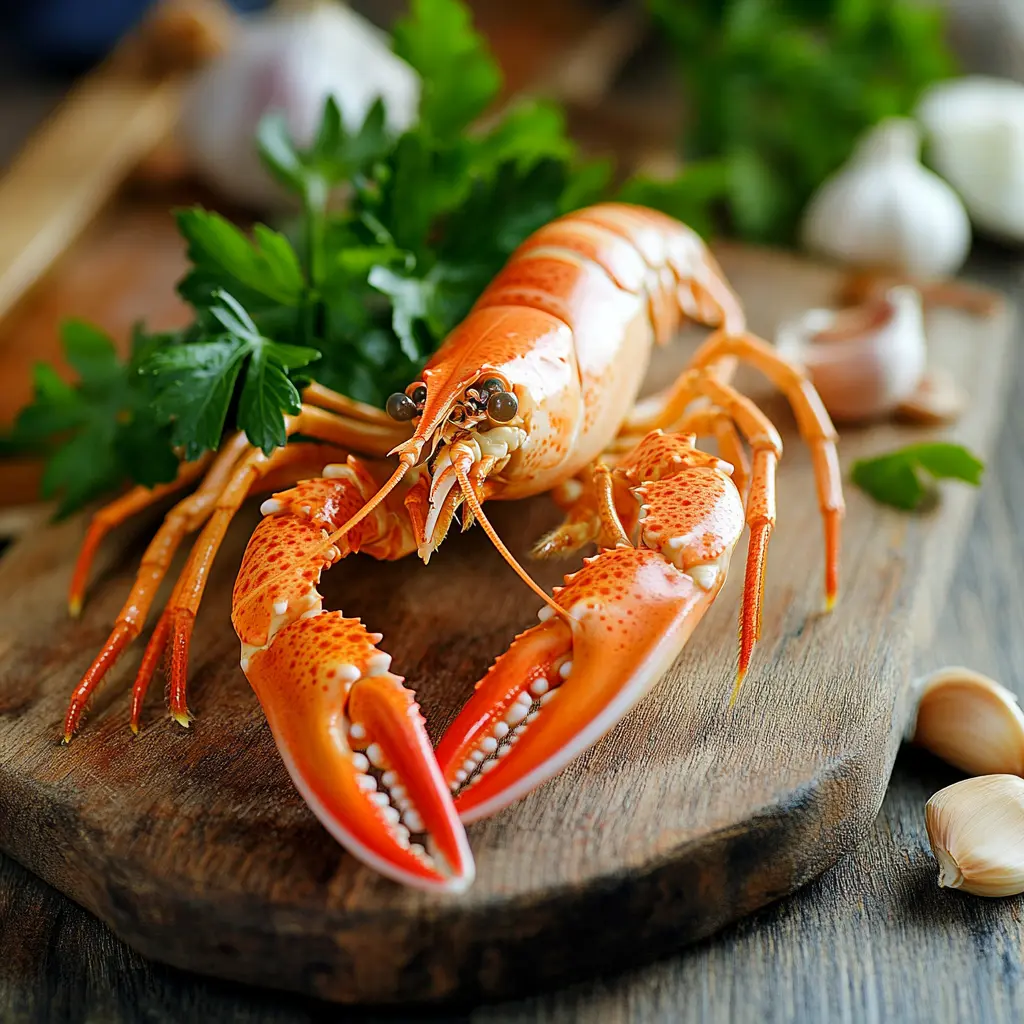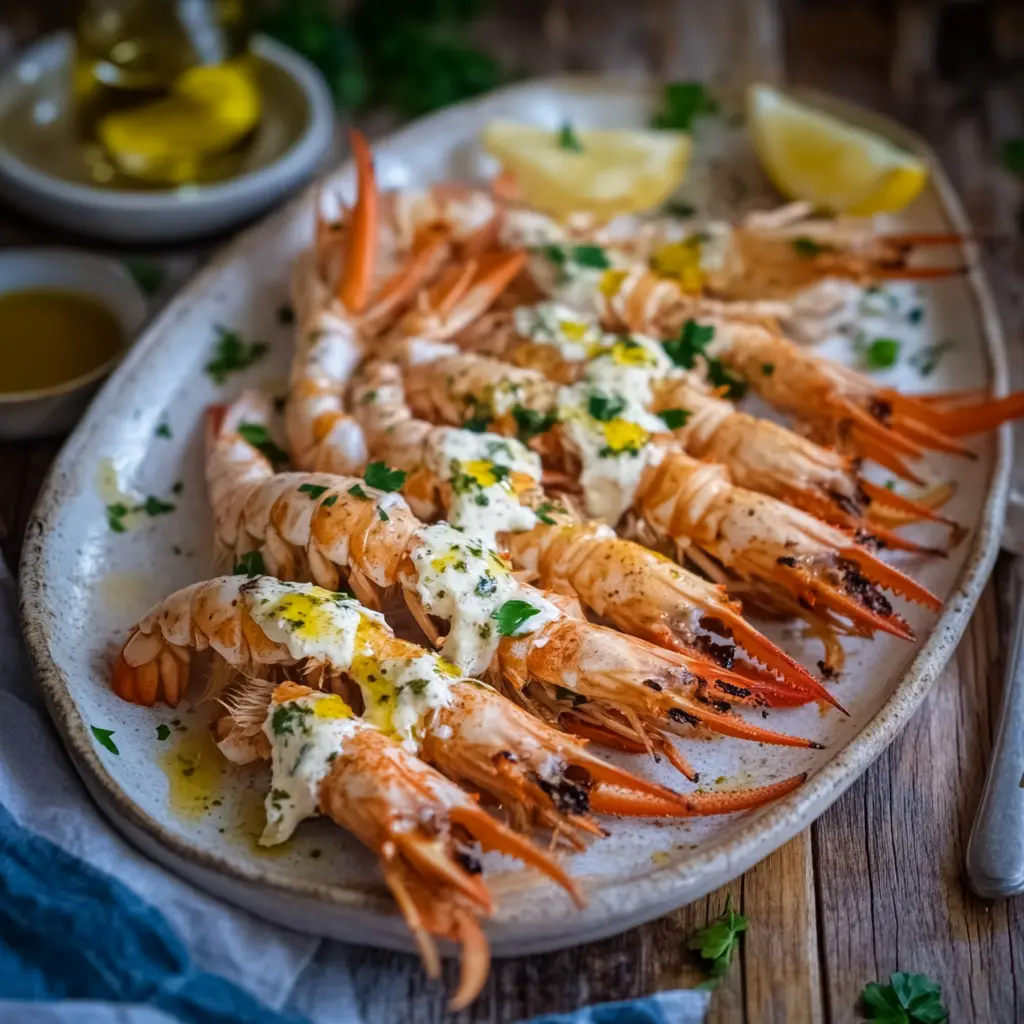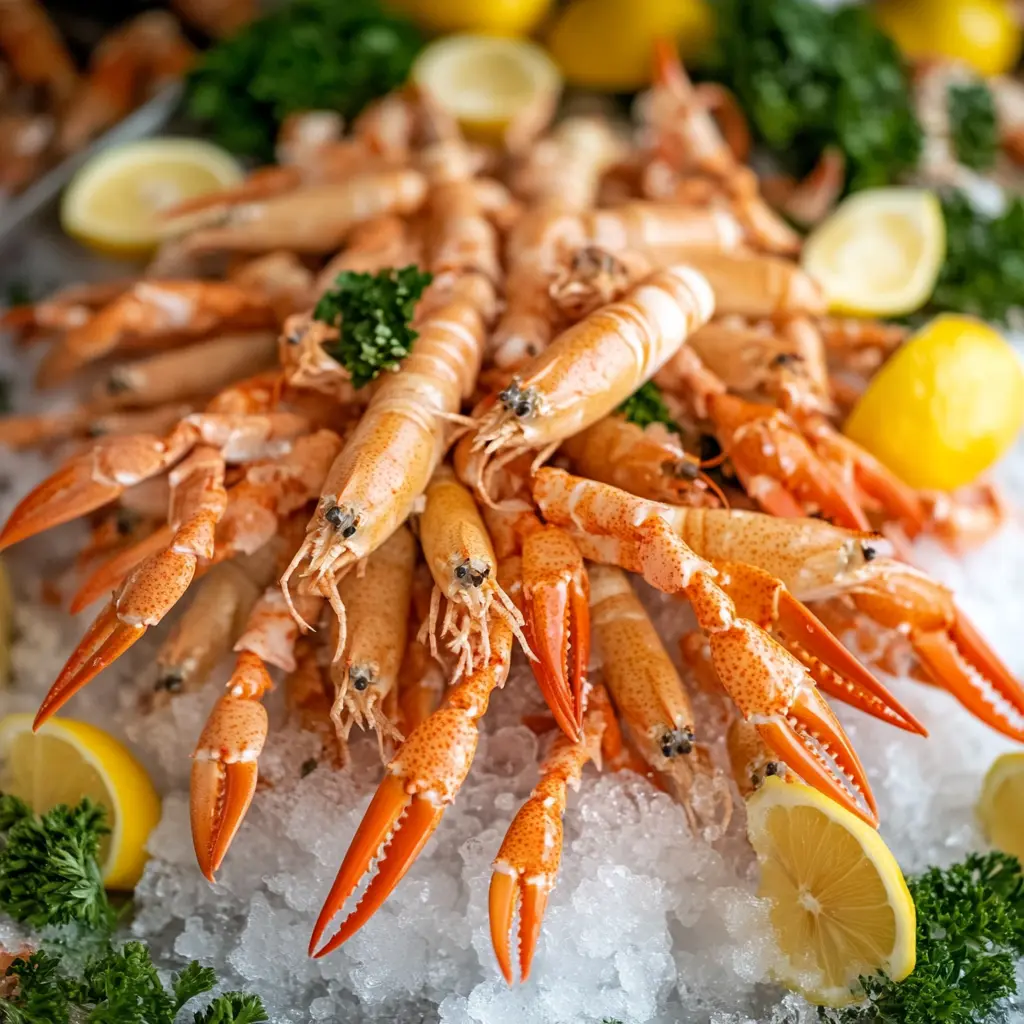What’s Langoustine ? Langoustine, often referred to as Norway lobster, is a prized crustacean loved by seafood enthusiasts and gourmet chefs worldwide. Known for its delicate flavor, tender texture, and elegant appearance, langoustine occupies a special place in high-end dining and culinary traditions. While it resembles a small lobster in appearance, langoustine has its own unique characteristics that set it apart. https://royalesrecipes.com/langoustine-recipe-a-culinary-delight-for-seafood-lovers/
In this comprehensive guide, we’ll explore what langoustine is, its origins, culinary uses, nutritional benefits, and why it’s considered one of the most luxurious seafood options available. By the end, you’ll understand why this crustacean is celebrated globally and how you can incorporate it into your own meals.
In This Recipe
Norway lobster ? What’s Langoustine ?
Langoustine (Nephrops norvegicus), commonly known as Norway lobster, is a type of crustacean that combines the best qualities of lobster and shrimp. Though they resemble small lobsters, langoustines belong to the same family as prawns and have their own unique characteristics that set them apart.
Physical Characteristics
Langoustines are smaller and more slender than lobsters, measuring between 6 and 10 inches in length. Their vibrant orange-pink shells make them visually striking, and these shells take on a brighter hue when cooked. The meat, primarily found in the tail, is tender and delicate, offering a melt-in-your-mouth experience that’s highly prized by chefs and seafood enthusiasts.
Flavor Profile
Langoustines are celebrated for their naturally sweet and subtle flavor, often described as a perfect blend of lobster’s richness and shrimp’s lightness. Their mild taste makes them highly versatile, able to pair well with both simple and complex seasonings.
Habitat and Origins
Langoustines thrive in the cold waters of the North Atlantic and parts of the Mediterranean Sea. They are found on the seabed at depths ranging from 60 to 400 meters, where they burrow into sandy or muddy substrates for protection. Countries like Scotland, Ireland, Norway, and Iceland are known for harvesting langoustines, making these regions some of the top suppliers globally.
Why Are Langoustines Called Norway Lobsters?
Despite being referred to as Norway lobsters, langoustines are not true lobsters. They share similarities with lobsters in appearance but are closer to shrimp in their family classification. The term “Norway lobster” likely stems from their abundance in the cold, pristine waters off Norway’s coast.
Langoustines stand out as a gourmet seafood delicacy thanks to their sweet flavor, tender texture, and visually striking appearance. They’re not just smaller versions of lobsters—they’re a unique crustacean with qualities that make them one of the most sought-after ingredients in global cuisines.
Key Characteristics :

Langoustines, also known as Norway lobsters, are a standout crustacean celebrated for their unique qualities. Their physical traits, flavor, and culinary versatility make them a prized ingredient in kitchens worldwide. Here’s a detailed look at what sets langoustines apart:
1. Size and Appearance Langoustine crustacean What’s Langoustine ?
- Size: Langoustines are smaller and more slender than traditional lobsters, typically measuring 6 to 10 inches in length.
- Shell Color: They have a vibrant orange-pink shell that becomes even brighter when cooked, making them visually striking on any plate.
- Claws: Their long, slender claws add to their elegant appearance and contain a small amount of flavorful meat.
2. Sweet and Delicate Flavor What’s Langoustine ?
- Natural Sweetness: Langoustines are known for their sweet, mild flavor, often described as a cross between lobster and shrimp but with a more refined taste.
- Subtle Brininess: Their flavor carries a light hint of the sea, enhancing their versatility in both simple and complex recipes.
3. Tender Texture
- Melt-in-Your-Mouth Meat: Langoustines have a soft, tender texture, particularly in the tail, which is the most commonly consumed part.
- Juiciness: When cooked properly, their meat remains juicy and succulent, making them an indulgent choice for gourmet dishes.
4. Culinary Versatility

- Langoustines adapt well to various cooking methods, including grilling, boiling, steaming, sautéing, and frying.
- Their delicate flavor pairs effortlessly with simple ingredients like olive oil, garlic, and lemon, as well as richer sauces and spices.
5. Habitat and Harvesting ” What is Langoustine “
- Cold-Water Dweller: Langoustines live in the cold waters of the North Atlantic Ocean and parts of the Mediterranean Sea.
- Burrowing Behavior: They inhabit sandy or muddy seabeds at depths of 60 to 400 meters, where they dig burrows for protection.
- Harvesting: Fishermen typically catch langoustines using sustainable trawling methods to protect marine ecosystems.
6. Nutritional Benefits of Scampi seafood
- Langoustines are not only delicious but also nutritious, offering a high-protein, low-fat seafood option.
- They are rich in omega-3 fatty acids, vitamin B12, selenium, and iodine, supporting overall health.
Langoustines combine exquisite flavor, tender texture, and a visually stunning appearance, making them a favorite for both casual cooking and fine dining. Their unique characteristics ensure they stand out as one of the most luxurious seafood options available.
Where Do Langoustines Come From?
Langoustines inhabit the cold, deep waters of the North Atlantic Ocean and parts of the Mediterranean Sea. The majority of langoustines are harvested near Scotland, Ireland, Norway, and Iceland, where they are abundant in their natural habitat.
Habitat:
- Langoustines live on sandy or muddy seabeds, where they dig burrows to protect themselves from predators.
- They thrive at depths of 60 to 400 meters and are often found in colder climates.
Why Are Langoustines So Popular?
Langoustines are celebrated for their premium taste, versatility, and luxurious appeal. Here’s what makes them so special:
1. Unique Flavor Profile
Langoustines have a sweet, mild flavor with hints of brininess. Their taste is often described as a cross between lobster and shrimp, but more delicate and refined.
2. Culinary Versatility
Langoustines can be prepared in numerous ways, including grilling, boiling, steaming, or sautéing. Their meat adapts well to simple seasonings like garlic and lemon or more complex sauces.
3. Visual Elegance
Their bright orange-pink shells and elongated claws make langoustines visually stunning, whether served whole or as peeled tails in a dish.
How Langoustines Differ from Lobsters and Prawns
Langoustines share similarities with lobsters and prawns but also have distinct differences:
1. Compared to Lobsters:
- Size: Langoustines are smaller and more delicate.
- Flavor: Langoustines have a sweeter, lighter taste compared to the robust flavor of lobsters.
- Claws: Their claws are long and slender, unlike the large, meaty claws of lobsters.
2. Compared to Prawns: How Langoustines Stand Out
Langoustines and prawns are often compared due to their similar size and shared crustacean family, but they have distinct differences in flavor, texture, and culinary use. Here’s a closer look at how langoustines differ from prawns:
1. Flavor ” What is Langoustine “
- Langoustines: Their flavor is naturally sweet and delicate, offering a refined, lobster-like taste with a subtle hint of the sea. Langoustines are considered more luxurious and nuanced in flavor than prawns.
- Prawns: Prawns have a firmer texture and an earthier, brinier flavor, which is slightly less sweet and more robust compared to langoustines.
2. Texture ” What is Langoustine “
- Langoustines: The meat of langoustines is tender, soft, and almost melts in the mouth when cooked correctly. Their delicate texture adds a gourmet appeal to dishes.
- Prawns: Prawns have a firmer, slightly chewier texture, which makes them ideal for stir-fries and other high-heat cooking methods.
3. Appearance ” What is Langoustine “
- Langoustines: Langoustines have long, slender bodies and claws, with vibrant orange-pink shells that become brighter when cooked. Their elegant appearance makes them visually striking, especially in gourmet dishes.
- Prawns: Prawns have a more compact body with no claws and a range of shell colors, from brownish-gray to light pink, depending on the species.
4. Culinary Uses ” What is Langoustine “
- Langoustines: Their sweet flavor and tender texture make them ideal for luxurious dishes like bisques, risottos, pastas, and grilled preparations. Langoustines are often served whole or as peeled tails.
- Prawns: Prawns are more versatile and are commonly used in everyday cooking, such as stir-fries, curries, and grilled skewers. Their firmer texture holds up well in various recipes.
5. Price and Availability ” What is Langoustine “
- Langoustines: Due to their delicate nature, shorter shelf life, and limited harvesting regions, langoustines are considered a luxury seafood item and are often more expensive than prawns.
- Prawns: Prawns are widely available, often farmed or caught globally, making them a more affordable and accessible option for home cooks.
6. Culinary Perception ” What is Langoustine “
- Langoustines: Langoustines are viewed as a gourmet delicacy and frequently appear on high-end restaurant menus due to their sophisticated flavor and elegant presentation.
- Prawns: Prawns are a more common ingredient, widely used in home kitchens and casual dining for their ease of preparation and versatility.
7. Nutrition ” What is Langoustine “
- Langoustines: Langoustines are slightly leaner and lower in calories than prawns, making them a healthier choice for indulgent seafood dishes.
- Prawns: Prawns are also a nutritious option, rich in protein and essential vitamins, but they may have a slightly higher fat content depending on the species.
While both langoustines and prawns have their unique appeal, langoustines stand out as the more luxurious choice with their sweet flavor, tender texture, and elegant presentation. Prawns, on the other hand, offer affordability and versatility, making them a practical option for everyday meals.
Culinary Uses of Langoustine Langoustine seafood
Langoustines are highly versatile and can be featured in a variety of dishes. Here are some popular ways to enjoy them:
1. Grilled Langoustines
Split langoustines in half, brush with garlic butter, and grill for a smoky, savory flavor.
2. Langoustine Risotto
Add langoustine meat to creamy risotto for a rich, flavorful seafood entrée.
3. Langoustine Pasta
Toss langoustine tails with linguine, olive oil, garlic, and fresh herbs for an Italian-inspired dish.
4. Langoustine Bisque
Use langoustine shells to make a rich, creamy bisque that highlights their deep, savory flavor.
5. Tempura Langoustines
Coat langoustine tails in a light tempura batter and fry until crispy for an elegant appetizer.
Nutritional Benefits of Langoustines ” What is Langoustine “
Langoustines are not just a luxury food item; they are also packed with nutritional value:
- High in Protein: Supports muscle growth and repair.
- Low in Fat: A lean seafood option for those watching their fat intake.
- Rich in Omega-3 Fatty Acids: Promotes heart health and brain function.
- Loaded with Vitamins and Minerals: Provides vitamin B12, selenium, and iodine, essential for overall well-being.
How to Cook Langoustines ” What is Langoustine “
Cooking langoustines is simple and requires minimal preparation to bring out their natural flavor. Here’s a quick guide:https://www.greatbritishchefs.com/how-to-cook/how-to-cook-langoustine
1. Boiling
- Bring salted water to a boil.
- Cook whole langoustines for 2–3 minutes, then serve with lemon and butter.
2. Grilling
- Split langoustines in half lengthwise.
- Brush with olive oil or garlic butter and grill for 2–3 minutes per side.
3. Sautéing
- Heat olive oil in a pan.
- Add langoustine tails, garlic, and herbs, and cook for 3–4 minutes until opaque.
4. Steaming
- Steam whole langoustines for 4–5 minutes to preserve their sweet flavor and tender texture.
Interesting Facts About Langoustines ” What is Langoustine “
- They Have Many Names:
Langoustines are called “scampi” in Italy and “Dublin Bay prawns” in Ireland. - Sustainable Harvesting:
Many fisheries use selective trawling methods to minimize bycatch and protect marine ecosystems. - They’re a Seasonal Delicacy:
While available year-round, langoustines are most plentiful between May and September. - A Chef’s Favorite:
Their luxurious flavor and elegant appearance make langoustines a staple in fine dining.
FAQs About Langoustines ” What is Langoustine “
1. Are langoustines hard to cook?
Not at all! Langoustines cook quickly and require minimal preparation, making them an easy yet impressive seafood option.
2. Can I use frozen langoustines?
Yes, frozen langoustines are a great alternative to fresh ones. Just thaw them properly before cooking.
3. How do I serve langoustines?
Serve them whole with garlic butter or as peeled tails in pasta, risottos, or salads.
4. What makes langoustines sustainable?
Many langoustine fisheries follow eco-friendly practices like selective trawling, ensuring healthy marine populations.
5. What’s the best way to enjoy langoustines?
Grilled with garlic butter is a classic choice that highlights their natural sweetness and tender texture.
Conclusion
Langoustines are a true treasure of the sea, celebrated for their sweet flavor, tender meat, and culinary versatility. Whether served simply grilled with garlic butter, tossed into a luxurious pasta dish, or transformed into a rich bisque, langoustines elevate any meal with their elegance and gourmet appeal.
Now that you know what langoustines are, where they come from, and how to prepare them, it’s time to bring this seafood delicacy into your own kitchen. With just a few simple ingredients, you can create unforgettable dishes that showcase the exquisite taste of langoustines. Bon appétit!

